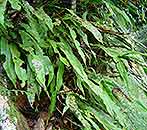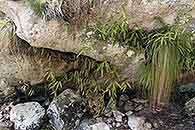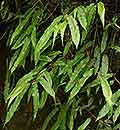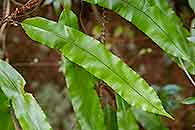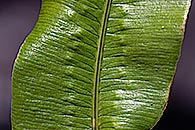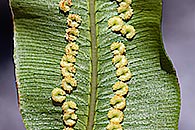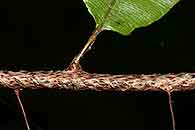Oleandra distenta Kunze
Synonyms |
Aspidium articulatum (Juss. ex Poir.) Willd. |
|---|---|
Common name |
|
Description |
Rhizome long creeping, up to 4 mm in diameter, scandent, branched; rhizome scales appressed, shiny, lanceolate, up to 7 mm long, with a dark brown central stripe and paler ciliate margins. Roots thin, wiry, singly below each old frond. Fronds widely spaced on rhizome or on short side branches, erect to arching, deciduous, simple. Stipe articulated near the base, up to 6 cm long, covered with scattered scales similar to, but smaller than those on the rhizome. Lamina 14-33 × 1.5-6.5 cm, glabrous on both surfaces, thinly membranous (dry) to thinly coriaceous, linear lanceolate in outline, base wedge-shaped, apex abruptly ending in a tip, margin subentire, wavy; midrib prominent below; veins obvious, simple, sometimes forked near the costa, finely parallel. Sori circular, up to 2.5 mm in diameter, in a irregular line on either side of the midrib, situated within the inner half of the lamina; indusium round to kidney-shaped, small, hairless, dark brown, entire. |
Notes | Can be separated from other ferns by the rampant rhizome with long filiform roots, the articulated stipe, the sori that are placed in 2 irregular rows on either side of the midrib and the round to kidney shaped indusium. |
Derivation | distenta: extended, stretched out; possibly referring to the widely spaced fronds on the widely creeping rhizome. |
Habitat | In high rainfall areas on boulders in riverine or montane forest, sometimes scrambling in trees in evergreen forest, or as a lithophyte on rock faces on mountain peaks. |
Distribution worldwide | Widespread in tropical and southern Africa. |
Distribution in Africa |
Angola, Burundi, Cameroon, Central African Republic, Congo, Dem. Republic of Congo, Equatorial Guinea (incl. Bioko), Ethiopia, Gabon, Ghana, Guinea, Ivory Coast, Kenya, Liberia, Malawi, Mozambique, Nigeria, Rwanda, Sierra Leone, South Africa, Sudan and South Sudan, Swaziland, Tanzania , Togo, Uganda, Zambia, Zimbabwe. |
Growth form |
Epiphytic, lithophytic. |
Literature |
|
